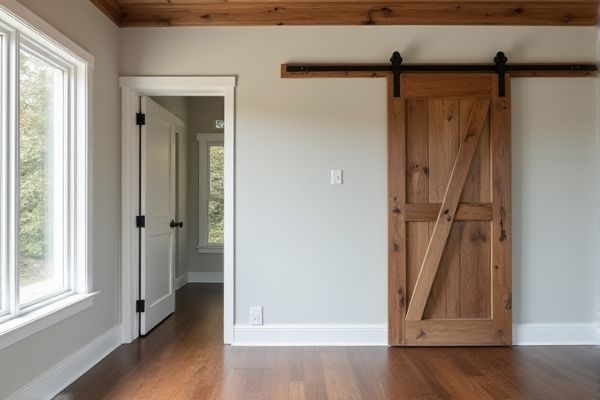
Swing doors offer traditional functionality with a clear swing radius, making them ideal for rooms where wall space is available, while sliding barn doors save space by gliding along the wall, perfect for smaller areas or adding rustic charm. Discover which door style best suits your home's design and functionality needs by reading the full article.
Table of Comparison
| Feature | Swing Door | Sliding Barn Door |
|---|---|---|
| Space Efficiency | Requires floor space to open | Does not require floor space; slides along wall |
| Installation | Standard hinge installation | Requires track and hardware installation above door frame |
| Design Style | Traditional and versatile | Rustic and modern farmhouse aesthetic |
| Accessibility | Easy to open, wide clearance | May limit opening width depending on wall space |
| Privacy & Sound | Better sealing; more privacy and sound insulation | Less sealing; sound can travel through gaps |
| Maintenance | Low; hinges need occasional lubrication | Track requires cleaning and lubrication |
| Cost | Generally lower initial cost | Higher cost due to hardware and installation |
Introduction to Swing Doors and Sliding Barn Doors
Swing doors offer a traditional, space-efficient entryway that swings open on hinges, making them ideal for rooms with ample clearance. Sliding barn doors slide along a mounted track, providing a rustic aesthetic while saving floor space, perfect for areas with limited room for door swing. Your choice between these door types depends on the desired style, functionality, and spatial constraints of your home or office.
Key Differences Between Swing Doors and Sliding Barn Doors
Swing doors operate on hinges and require clear space to open inward or outward, offering a traditional look and ease of use in tight spaces. Sliding barn doors glide along a track mounted above the doorway, saving floor space while adding a rustic, decorative element to your room. Your choice between these doors depends on space availability, aesthetic preference, and functional needs like sound insulation or accessibility.
Space Efficiency: Which Door Saves More Room?
Sliding barn doors save more room compared to swing doors by gliding parallel to the wall, eliminating the need for clearance space required for door swings. Swing doors require a clear radius equal to the door's width, reducing usable floor area in tight spaces such as small rooms or narrow hallways. For maximizing space efficiency in compact environments, sliding barn doors offer a superior solution by preserving floor space and allowing flexible furniture placement.
Aesthetic Appeal: Traditional vs. Modern Door Styles
Swing doors offer a traditional aesthetic appeal with classic frames and panel designs, complementing rustic and timeless interiors. Sliding barn doors provide a modern, industrial look featuring exposed hardware and minimalist lines, ideal for contemporary and open-concept spaces. Choosing between the two hinges on desired interior style, where swing doors evoke warmth and familiarity, while sliding barn doors deliver sleek sophistication and space-saving functionality.
Installation Process: Swing Door vs. Sliding Barn Door
Installing a swing door involves standard framing procedures with hinges attached to a door jamb, requiring precise measurements to ensure smooth opening within a fixed radius. Sliding barn doors demand a more complex installation, including mounting a heavy-duty track system above the doorway and ensuring the wall can support the door's weight, often involving reinforcement. While swing doors require less structural modification, sliding barn doors offer space-saving benefits but necessitate careful alignment and robust hardware.
Durability and Maintenance Considerations
Swing doors typically offer higher durability due to their robust hinges and fewer moving parts, making them less prone to mechanical wear over time. Sliding barn doors require regular maintenance of their tracks and rollers to ensure smooth operation and prevent alignment issues caused by dirt or debris. Your choice depends on the balance between ease of upkeep and the door's ability to withstand frequent use in varying environmental conditions.
Cost Comparison: Upfront and Long-Term Expenses
Swing doors generally have lower upfront costs due to simpler hardware and installation requirements, while sliding barn doors often involve higher initial expenses because of specialized tracks and mounting systems. Over time, swing doors usually incur lower maintenance costs, as sliding barn doors may require periodic track cleaning and hardware adjustments to ensure smooth operation. Considering your budget and long-term use can help determine which door type offers better value for your space.
Sound Insulation and Privacy Factors
Swing doors typically provide superior sound insulation and privacy due to their full-frame structure and tight seals around the edges, which effectively reduce noise transmission. Sliding barn doors often lack the robust sealing found in swing doors, resulting in more sound leakage and decreased privacy, especially in shared or high-traffic areas. For environments where noise reduction and privacy are critical, swing doors are generally the preferred choice.
Best Use Cases for Swing Doors and Barn Doors
Swing doors are ideal for traditional room entrances and areas requiring a tight seal, such as bedrooms and bathrooms, where privacy and sound insulation are priorities. Sliding barn doors excel in spaces with limited floor clearance or where maximizing usable square footage is essential, often enhancing aesthetic appeal in living rooms and closets. Your choice depends on whether you prioritize space-saving functionality or classic door operation in your interior design.
Conclusion: Choosing the Right Door for Your Space
Swing doors offer classic functionality and space-saving simplicity, making them ideal for traditional layouts or areas requiring tight seal and soundproofing. Sliding barn doors maximize usable floor space and provide a rustic aesthetic, perfect for open-concept rooms or smaller areas where swing clearance is limited. Selecting the right door depends on room size, design preference, and functional needs such as privacy or ease of access.
 homyna.com
homyna.com